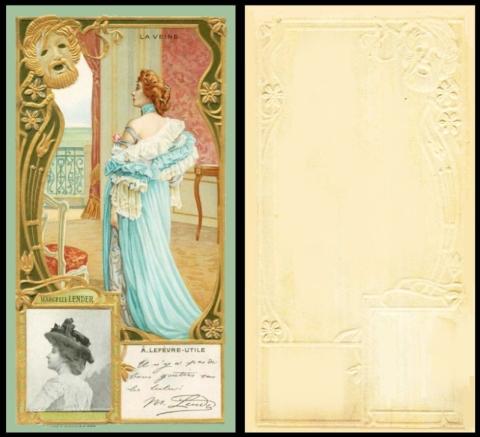
Now this set is not titled, but above the mask it says "La Veine", which translates to vanity. Whilst that is not strictly a deadly sin in either French or English - the list being l'orgueil (pride), l'avarice (greed), l'envie (envy), la colère (wrath), la luxure (luxury, or lust), la gourmandise (gluttony), and la paresse (sloth), respectively - it is definitely related.
Many of these things also relate to expensive shoes (etc), the pride or showing off in wearing them, the greed of stealing or making money by unfair means to afford them, the envy and wrath some people feel towards anyone with more beautiful things, the feeling of luxury to the wearer, and the gluttony, perhaps, if they are not satisfied with the one single pair.
However the card was actually picked because the person shown is not just a beauty, she is, or was, a celebrity, and though Mr. Ferragamo himself may not be seen as such, there is no denying that for the most part it is only celebrities who wear his finest creations.
Her name was Marcelle Lender, and she was an actress and dancer. More than that, though, she was a great favourite of Henri de Toulouse-Lautrec, whose most famous painting of her is called "Mademoiselle Marcelle Lender, Bust-Length", and it was painted in 1895, just six years before his death, at the age of thirty-seven.
That was the year that she starred in a revival of the operetta, "Chilperic", at the Theatre des Varietes, which he attended more times than anyone could count, and possibly more times than he revealed to any of his friends. She played the part of a Visigoth princess, called Galeswinthe, and, for whatever reason, during the performance she danced the bolero, clicking away rapidly with a pair of castanets. She hardly ever faced the audience, but Toulouse-Lautrec was able to recall the moments that her face shone towards him, and, unusually, she is the only one of all his subjects whose representation may be termed a proper portrait, rather than a caricature or impression.
We do not, and probably will never know why he was so attracted to her. She was neither young, nor slim, but she had something which completely captivated him. Perhaps it was her freedom, her spirit. Or perhaps, simply, because of her brilliant orange hair, which she whirled freely whilst dancing; hair made even more orange by the fact that she artificially lightened her facial complexion.
As for our issuer, Lefevre-Utile, they are still a household name, though you may know them better as "LU". One of their best known brands are the original "Petit Beurre"
They were originally made in France, in Nantes, in 1846, by a patissiere, Jean-Romain Lefèvre, who sold cakes and biscuits.
In 1850, he married Pauline-Isabelle Utile, and the name of the shop changed, to Lefevre-Utile, a combination of their surnames. She was obviously a very modern and forward thinking bride who decided to keep her own name rather than be subsumed into taking his instead.
However the first time the company name appears on any advertising was in the late 1890s. Now this may be something to do with the fact that although he sold biscuits, he did not make them - instead, he imported them, from England, from none other than Huntley and Palmer. Then, as you do, perhaps with a wifely nudge or two, he wondered how hard it would be to make his own. Obviously it was not so tough, because he stopped importing them.
Now Pauline-Isabelle Utile was actually from Nantes, whilst Jean-Romain Lefevre came from Meuse. They had four children, Ernest, the oldest, who was born in 1851 and died at the start of the Second World War, Auguste (about whom nothing is known save his birthdate of 1854), Pauline, named after her mother, who was born in 1855 and died relatively young at the age of thirty nine, and Louis who was born in 1858 and also died during the Second World War, in 1940. However he was the one who inherited the company, in 1882, after the death of his father - and he was also the one who actually invented their best selling line, the "Petit Beurre"
Pauline Lefevre-Utile lived on for quite some time and only died in April 1922, still in Nantes, aged ninety-one.
